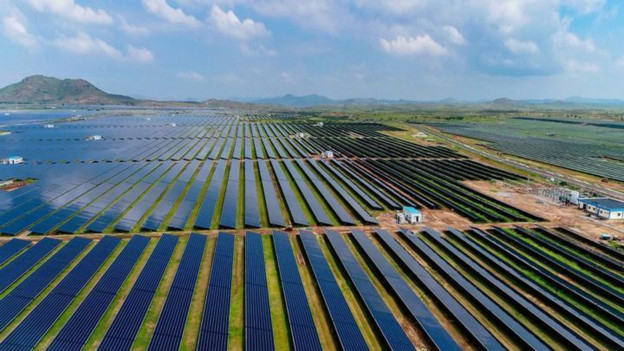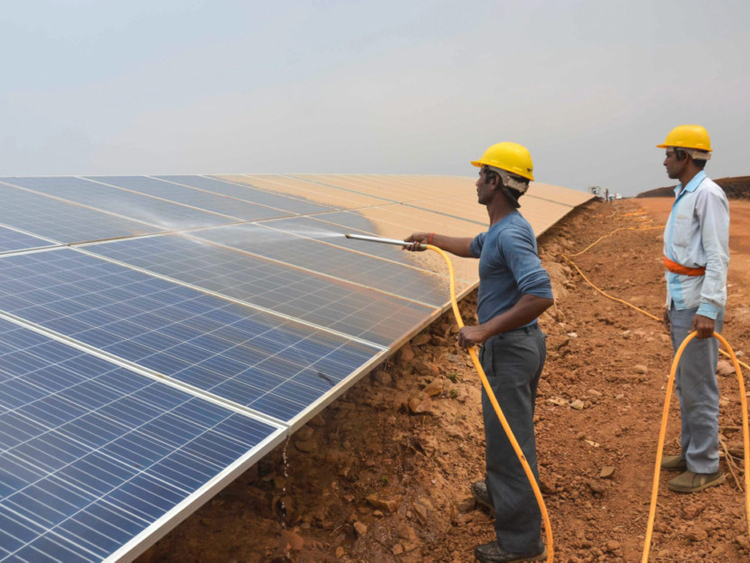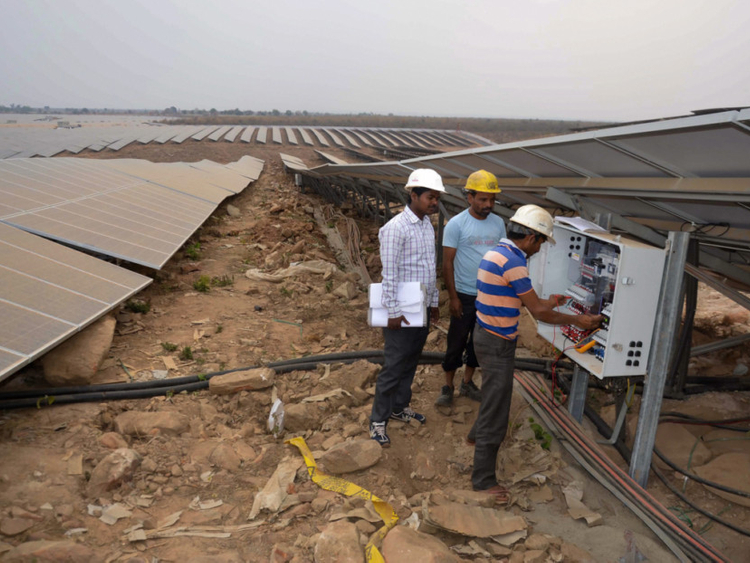
Pavagada, India: Weeds poke listlessly from the flat, rocky earth as the temperature climbs to the mid-90s. On a cloudless March afternoon, the blue horizon stretches out uninterrupted, as if even birds are too weary to fly.
On this unforgiving patch of southern India, millions of silver-gray panels glimmer in the sun, the start of what officials say will be the biggest solar power station in the world.
When completed, the Pavagada solar park is expected to produce 2,000 megawatts of electricity, enough to power 700,000 households - and the latest milestone in India’s transition to generating more green energy.
Long regarded as a laggard in the fight against climate change, India is building massive solar stations at a furious clip, helping to drive a global revolution in renewable energy and reduce its dependence on coal and other carbon-spewing fossil fuels blamed for warming the planet.
While the Trump administration abandons the Paris agreement on fighting climate change and pledges to revive the US coal industry, India this month hosted the inaugural conference of the International Solar Alliance, an organisation launched by Prime Minister Narendra Modi with the aim of raising $1 trillion to promote solar generation and technology in 121 countries.
Thanks to low-cost solar panels and government incentives for renewable energy, India surged past Japan last year to become the world’s third-biggest market for solar power, after China and the United States. Modi has called for generating 100 gigawatts of solar capacity by 2022 - nearly 30 times what it had three years ago, and equivalent to the entire energy output of Spain.
India’s need for green energy is obvious. With an economy expanding at roughly 7 percent annually, and ambitions to bring electricity to hundreds of millions of people who still lack it, India must pump up solar and wind power dramatically in order to meet its commitments under the Paris agreement. Air pollution has worsened in its cities, partly because of emissions thrown up by old power plants.
India has approved plans for 14 solar parks larger than Solar Star, the 579-megawatt Solar Star power station just north of Lancaster, in the Antelope Valley in California.
Most lie in India’s northern deserts and southern scrubland, where state and local authorities are racing to fulfill Modi’s agenda and foreign companies are vying for pieces of perhaps the last great solar market.
“The potential of solar power in India is huge,” said Sanjay Aggarwal, managing director of the Indian office of Fortum, a Finnish energy company that is generating 100 megawatts at Pavagada.
Unlike in the United States, Germany, Australia and other nations with large renewable programs, the vast majority of solar power in India and China comes not from decentralised rooftop panels but from expansive parks. Indian authorities have enticed developers by acquiring land, building transmission links and offering up buyers for the new power, usually state-owned companies with low default risk.
“The land is taken care of, the transmission is taken care of - these are big headaches in India,” said Rahul Tongia, an expert on technology policy at the Brookings India think tank.
“The idea is, ‘If you build it, they will come,’ and it’s a smart design if you’re trying to expand quickly.”
By next year, the largest solar park of all could lie on 20 square miles in Pavagada, in a dry belt of the southern state of Karnataka that sees more than 300 sunny days a year.
Coal still accounts for 58 percent of India’s power, while wind provides 10 percent and solar 5 percent, according to government figures. India had created 20 gigawatts of solar power at the end of December, nearly doubling its capacity from a year earlier.
On a recent afternoon, as groundskeepers whacked at weeds outside a cluster of trailers in Pavagada, technicians scanned monitors that tracked the output of the plant’s 1 million Malaysian-made panels.
The ultra-thin gray modules were designed to withstand intense heat. As data showed the temperature of the panels rising to 124 degrees, plant manager Rajendra Gupta looked up approvingly.
“We are at maximum output today,” Gupta said. “These are very good conditions.”
Experts say India’s experience could serve as an example for other sun-drenched parts of South Asia and Africa.
“This is a model India is trying to export to other developing countries,” said Deepak Krishnan, manager for the energy program at the World Resources Institute. “It’s the purpose of the International Solar Alliance - to show that you can go on a massive transition, and that these are not Western models but something we have developed for ourselves.”
BOX
There are other clouds on the horizon
State officials said Pavagada’s remaining 1,400 megawatts would be online by year’s end, but they have hit delays in construction and bidding.
Prices of solar panels, which were falling for years, have risen slightly with the introduction of a complicated new national sales tax. And as Trump did in January, Modi is considering levying heavy tariffs on imported solar panels in an effort to boost struggling domestic manufacturers. More than 80 percent of India’s solar modules come from China, Taiwan and Malaysia.
“Module cost typically forms around 55 percent of the cost of a solar project,” Fortum’s Aggarwal said. “It’s not rocket science that if the cost of the raw material goes up, growth is going to slow down.”
Bridge to India, a consulting group, forecast that India would add six gigawatts of solar power capacity in 2018, one-third less than last year, due to the uncertainty over costs.
Further jeopardising Modi’s 100-gigawatt target are questions over the government’s ability to secure land for additional large-scale parks. In some areas, villagers have argued that solar farms might harm the environment because of the huge amounts of water required to keep panels clean.
“We do see some challenges because the low-hanging fruit in terms of land acquisition is being cherry-picked,” said Vinay Rustagi, Bridge to India’s managing director. “Over a period of time, for even the government to identify thousands of acres will become a problem.”
As its share of renewable energy resources grows, India also must retrofit its aging, inflexible energy grids to integrate more solar and wind power.
“It’s not just about building bigger transmission links, but more has to be done to absorb green power,” Rustagi said.














